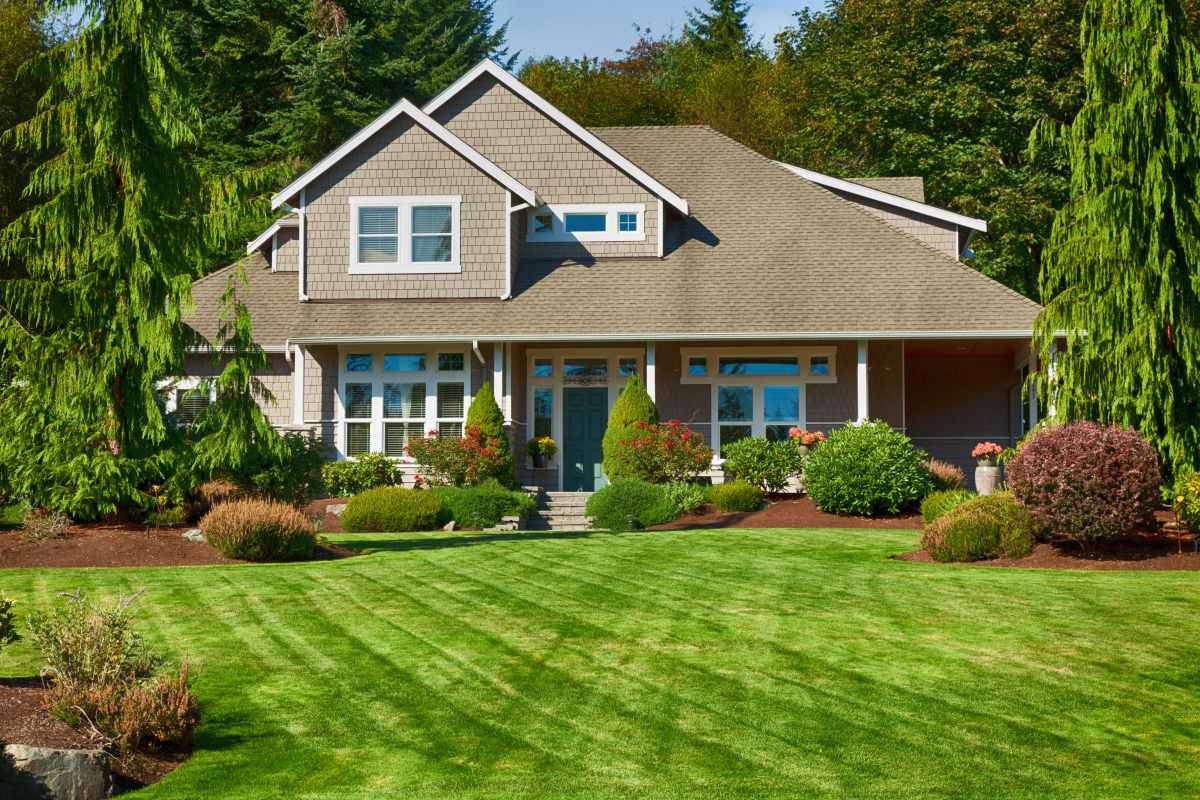
Cool-season grasses like Kentucky bluegrass, fine fescue, tall fescue, and perennial ryegrass grow best in Harrisburg. However, the southernmost part of Pennsylvania is in the transition zone, meaning warm-season grasses like Zoysia can grow here, too.
Harrisburg experiences four seasons, so lawns encounter stress from extreme temperature fluctuations, snow, and ice. You need grass that can survive temperatures in the single digits but also withstand warm and humid summers. Beyond that, these grasses have different characteristics that make them more, or less, suitable for your lifestyle and preferences.
We’ll go into all those considerations below as we explore the five best grass types for Harrisburg:
4 Cool-Season Grasses
Cool-season grasses grow best in the cooler months, so they are ideal for Harrisburg’s spring and fall seasons. These grasses may go dormant during the short, hot summers. However, they bounce back well and remain green through the winter.
1. Kentucky Bluegrass (Poa pratensis)
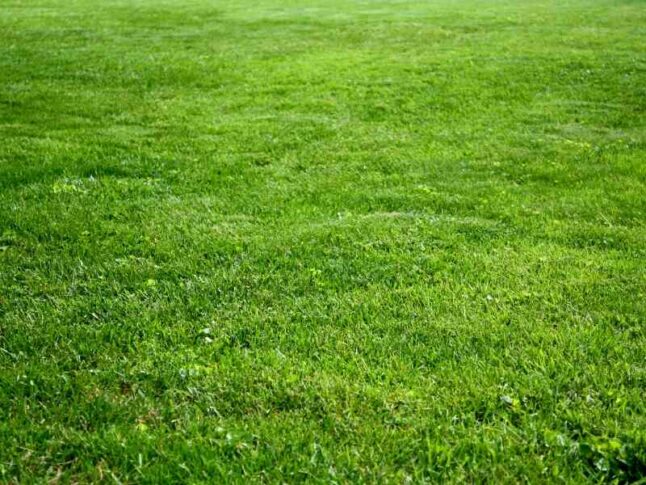
Homeowners love that Kentucky bluegrass (KBG) has a rich, bluish-green color and is durable. In fact, KBG is so resilient it is commonly used in parks and athletic fields. It has a medium texture and prefers full sun.
Mixing bluegrass with another grass variety can increase its shade, pest, or disease tolerance. For a shady lawn, combine KBG with fine fescue or perennial ryegrass.
Let’s take a look at the pros and cons of this cool-season variety:
Pros
- High cold tolerance
- Recovers quickly, so it has excellent wear resistance
- Produces a dense lawn
Cons
- Low heat tolerance; will go semi-dormant in the summer
- High-maintenance
- Low disease resistance
- Classification: Cool-season grass
- Spreads by: Rhizomes
- Shade tolerance: Low
- Drought tolerance: Moderate
- Foot traffic tolerance: Moderate
- Maintenance needs: Moderate mowing frequency and high fertilization needs.
- Mowing height: Set mowing height between 2.5 and 3.5 inches.
- Potential for disease: Moderate to high; prone to several diseases, such as dollar spot, leaf spot, necrotic ring spot, summer patch, and stripe smut.
- Soil pH: 6-7.5
- Soil type: Performs best in well-drained, heavy soils with high fertility.
Grass Seed Options:
– Jonathan Green (11970) Blue Panther Kentucky Bluegrass Grass Seed (3 lbs.)
– SeedRanch Midnight Kentucky Bluegrass Seed (5 lbs.)
– Jacklin Seed – Biltmore Blue Blend – 100% Kentucky Bluegrass (5 lbs.)
2. Fine Fescue (Festuca spp.)
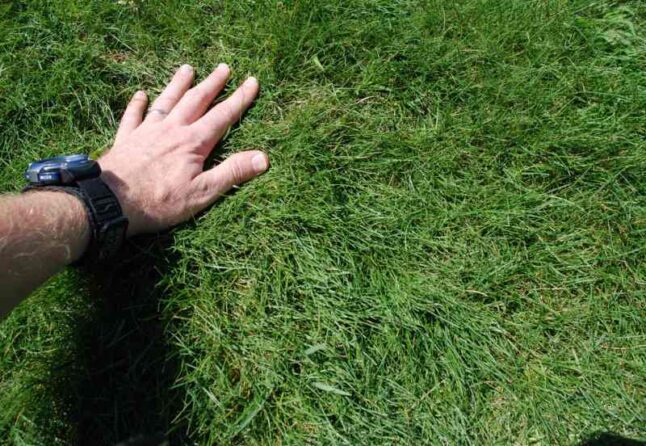
Of all the cool-season grasses, fine fescue has the highest shade tolerance. Chewings fescue, hard fescue, sheep fescue, and creeping red fescue perform well in the Quaker State, with chewings being the most shade-tolerant.
Fine fescue has a blue-green color and a fine, soft texture. Its foot tolerance ranges from low to moderate. However, if you prefer low-maintenance grass, you’ll love fine fescue.
Pros
- Drought-tolerant
- Adapts to poor soil
- High shade tolerance
- More resistant to snow mold than other cool-season grasses
- Low-maintenance
- Thatch development is minimal
Cons
- Semi-dormant during heat waves
- Low foot-traffic tolerance
- Classification: Cool-season grass
- Spreads by: Bunch-type grasses
- Shade tolerance: Moderate to High, depending on the species
- Drought tolerance: Moderate to High, depending on species
- Foot traffic tolerance: Low to Moderate, depending on the species
- Maintenance needs: Low fertilizer and mowing needs.
- Mowing height: Set mowing height between 2.5 and 4.0 inches, depending on species.
- Potential for disease: Moderate. Common diseases include red thread, leaf spot, dollar spot, summer patch, and powdery mildew.
- Soil pH: 6-6.5
- Soil type: Will not perform well in wet soil conditions. Prefers drier soils and tolerates a wide range of soil types and fertility.
Grass Seed Options:
– Outsidepride Legacy Fine Fescue Grass Seed (5 lbs.)
– Eretz Creeping Red Fine Fescue Seed (choose your size)
– Outsidepride Creeping Red Fine Fescue Grass Seed (25 lbs.)
– Outsidepride Hard Fine Fescue Grass Seed (10 lbs.)
3. Tall Fescue (Festuca arundinacea)
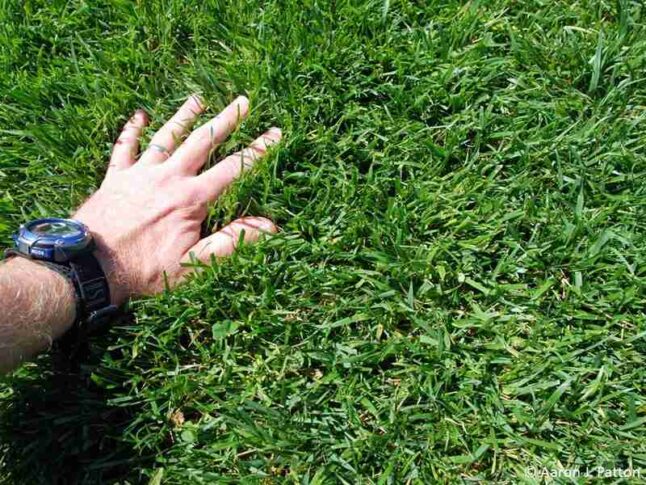
Tall fescue is another variety commonly found in public gathering places, like parks and sports fields. It generally has a medium texture, though newer strains have a softer feel and dark green color.
You get the best of both worlds with tall fescue; although it thrives in full sun, it adapts to partial shade and prefers well-drained soil.
Pros
- Heat-tolerant
- Drought-tolerant
- Does not develop significant thatch
- Shade-tolerant
- Disease-resistant
Cons
- Requires frequent mowing
- Sparse appearance
- Classification: Cool-season grass
- Spreads by: Produces short rhizomes but has a bunch-type growth habit
- Shade tolerance: Moderate
- Drought tolerance: Moderate to High
- Foot traffic tolerance: Moderate
- Maintenance needs: Frequent mowing. Does not produce significant thatch.
- Mowing height: Set mowing height to 2 inches when the grass reaches 3 inches tall.
- Potential for disease: Tolerant of most diseases when properly maintained. Pythium blight, brown patch, and red thread pose significant threats.
- Soil pH: 5.5-6.5
- Soil type: Adapted to a wide range of soil conditions, but prefers fertile clay soils with good drainage.
Grass Seed Options:
– Triple-Play Tall Fescue Grass Seed Blend (5000 sq ft)
– Eretz Kentucky 31 K31 Tall Fescue Grass Seed (choose your size)
– Pennington The Rebels Tall Fescue Grass Seed Mix (7 lb.)
4. Perennial Ryegrass (Lolium perenne)
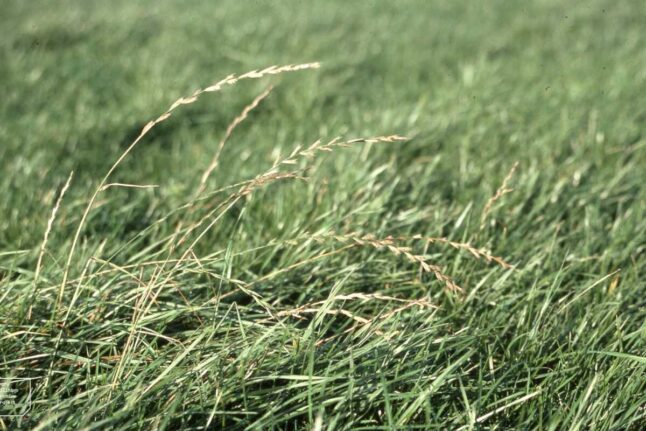
Perennial ryegrass grows well in full sun; it requires a lot of light to perform optimally. It is commonly mixed with fine fescue and KBG, and like these grasses, perennial ryegrass prefers well-drained soil.
Perennial ryegrass is dark green, has a medium texture, and germinates quickly. It is often used for overseeding bare patches or establishing a new lawn.
Pro Tip: Do not use more than 15% to 20% of perennial ryegrass in mixtures because it grows rapidly and can prevent other species from growing.
Pros
- Establishes quickly
- Heat-tolerant
- High foot-traffic tolerance
- Moderate mowing and fertilization requirements
- Not prone to thatch
Cons
- Aggressive growth may outcompete other grass types
- Low disease resistance
- Not drought-tolerant
- Classification: Cool-season grass
- Spreads by: Has a bunch-type growth habit
- Shade tolerance: Low
- Drought tolerance: Low
- Foot traffic tolerance: High
- Maintenance needs: Moderate mowing and fertilization requirements. Thatch is not significant.
- Mowing height: Set mowing height to 1.5 to 2.5 inches
- Potential for disease: High. Common diseases include gray leaf spot, red thread, and leaf spot/melting-out.
- Soil pH: Can grow in soils with a pH between 5 and 8, but prefers between 6 and 7.
- Soil type: Prefers good drainage and fertility, but can tolerate some poor drainage.
Grass Seed Options:
– Outsidepride Perennial Ryegrass Seed (5 lbs.)
– Eretz ProTurf Perennial Ryegrass Fine Lawn Seed (choose your size)
Warm-Season Grass
Warm-season grasses grow best in the summer and go dormant when soil temperatures drop below 50 degrees Fahrenheit. They grow actively in the late spring and summer and go dormant sooner than cool-season varieties in Pennsylvania.
5. Zoysiagrass (Zoysia sp.)
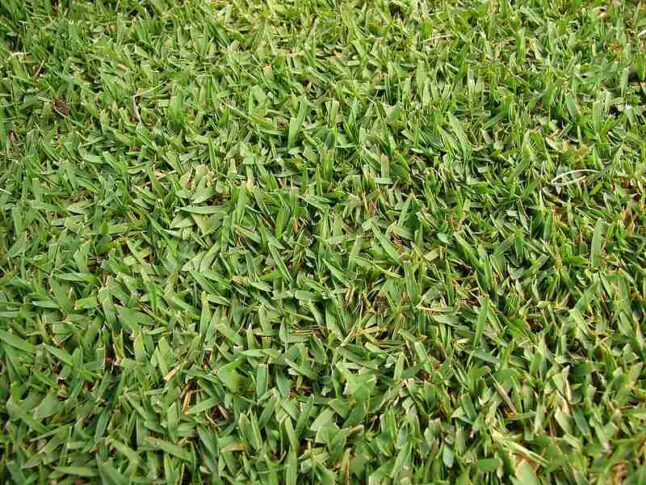
Because Zoysiagrass is a warm-season grass, Harrisburg’s cold and frosty winters mean this grass type will be brown most of the year. However, it will bounce back in the late spring or early summer and even thrive in partial shade.
Zoysiagrass is a favorite because it is low-maintenance, and its slow growth habit means it does not need frequent mowing or fertilization.
Pros
- Excellent foot-traffic tolerance
- Adapts to soil types
- Heat-tolerant
- Shade-tolerant
- Higher cold tolerance than other warm-season grasses
- Low-maintenance
Cons
- Remains brown most of the year in Harrisburg’s climate
- Recovers slowly from damage
- Classification: Warm-season grass
- Spreads by: Stolons and rhizomes
- Shade tolerance: Moderate
- Drought tolerance: Moderate to High
- Foot traffic tolerance: High, but recovers slowly from damage
- Maintenance needs: Low nitrogen fertilization requirements; prone to thatch build-up
- Mowing height: Set mowing height between 1 and 2 inches.
- Potential for disease: Good disease tolerance overall. But Zoysiagrass is vulnerable to some lawn diseases, like large patch disease. Zoysia also attracts a few pests, namely white grubs and mole crickets.
- Soil pH: 6-6.5
- Soil type: Well-draining; some cultivars are more tolerant of a wide range of soils than others.
Grass Plug and Seed Options:
– Zoysia Plugs (50 Large Grass Plugs)
– Zoysia Plugs (50 Full & Lush Grass Plugs)
– Zoysia Plugs (100 Plugs)
– Zoysia Emerald Grass Seeds (1/8 lb. of seeds)
– Zenith Zenith Grass Seeds (1/8 lb. of seeds)
Choosing a Grass Variety in Harrisburg
Choosing the best grass variety for your lawn depends on multiple determinants. Maintenance preferences and use should be considered along with environmental factors, like:
Shade Tolerance
Grass typically needs at least six hours of full sun to thrive. It is best to know how sunlight is distributed across your yard and how much light your property gets.
Drought Tolerance
Many states are embracing landscaping that protects natural resources and conserves water. Pennsylvania offers a Lawn Conversion Program to help implement natural landscaping to support Harrisburg’s environment. Lawn owners are encouraged to convert their backyards into meadows and woods, which require less watering and maintenance.
If you’re not ready to go that far, you can start with drought-tolerant grass like fine fescue.
Pest Tolerance
A grass’s vulnerability to pests can impact how much maintenance the grass will need. If you think you have lawn pests, treat them immediately or call a professional. Climate and cultivar affect a grass’ pest resistance.
Foot Traffic
Do you avoid walking on your grass and keep others off it, too? Or, is your home the house on the block buzzing with lawn activity? Whether children are running across the grass regularly or your lawn is more like an art piece hanging in a museum with a, “Do not touch” sign, knowing how different types of grass handle foot traffic can help you choose the right grass for your yard.
Maintenance Level
At the end of the day, someone has to do the upkeep or pay professionals to keep the lawn mowed, trimmed, edged, and more. It doesn’t matter if you want to spend your time at the Broad Street Market or on the Pride of the Susquehanna. If you want to do as little yard work as possible, maintenance requirements are a priority in grass selection.
Hiring a Professional in Harrisburg
Hopefully, now you can select a grass that enables you to put together an immaculate lawn that can thrive in Harrisburg while meeting your needs and maintenance preferences. But if it is all a bit overwhelming, LawnStarter can help.
LawnStarter connects you to lawn care professionals who mow, trim, edge, and more to keep your lawn green and healthy. Contact us for a quote today. Let us do the work so you don’t have to.
LawnStarter participates in the Amazon Services LLC Associates Program, an affiliate advertising program. LawnStarter earns revenue from products promoted in this article.
Main Photo Credit: akurtz / Canva Pro / License